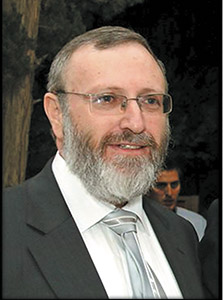
Confined to the Lublin Ghetto, a young rabbi recorded the hopes and hardships of the community. He speaks to us, today, in the closing entry of his diary, found long after the Holocaust:
“Before the war, my wish was to bring greater faith and goodness into the world. Later, my dream was that my son would grow to become a scholar. As things got worse, I hoped he would survive to tell the world what happened. Now, I can only pray that these pages will someday be found and bear witness, but I fear that even this will not be.”
Shem Olam found his priceless pages. Shem Olam is fulfilling his last wish.
Suffering, mass murder, starvation, absence of humanity, annihilation. These are the images that we are all familiar with when describing the events of the Shoah, the Holocaust.
However, the Shoah was also about the power of coping, the allegiance to moral values, the retention of the human image and the survival of spirit and faith. These insights are the focus of the Shem Olam Institute, founded in 1996 by Rabbi Avraham Krieger in Kfar Haroeh, located in the Chefer Valley in central Israel. Rav Krieger, the son of survivors of the ghettos, labor camps and of Auschwitz-Birkenau, learned of a realm of spiritual resistance in the ghettos and camps that can and must be uncovered, documented and preserved in our memories and consciousness. Recognizing the importance of this information, Rabbi Krieger began to seek out, acquire, and study documents, photographs, and artifacts from all over Europe where history lies dormant in corners, drawers, boxes and shelves; in attics, governmental archives, offices and abandoned houses, materials that provide extensive and systematic evidence of the widespread dedication to Jewish ethics and personal dignity.
Shem Olam’s mission is to salvage the remaining historical remnants of the Holocaust by engaging the expertise of 11 full-time skilled researchers in Eastern Europe; administering two professional research institutes in Eastern Europe and Israel; and sponsoring regular document and artifact recovery missions to Europe.
The organization seeks to document religious and spiritual life during the Holocaust by housing over 750,000 documents and artifacts from the era of the Holocaust, maintaining an extensive and publicly accessible research library, and obtaining and cataloguing eyewitness testimonies.
Shem Olam educates the world about spirituality during the Holocaust by operating a Pedagogic Center that has already welcomed many visitors, showcasing a museum that focuses on ethical and moral dilemmas of the era, creating and distributing comprehensive curricular materials in Hebrew and English, holding public seminars and workshops, and conducting group trips to the lost communities of Eastern Europe—defining how the kedoshim lived through each day, struggling with their wretched conditions and at the same time trying to deal with their spiritual and religious inner feelings and practices. Here are two samples of such findings:
A diary found in the Warsaw Ghetto where at the time, the daily food ration was 180 calories; the monthly allotment of margarine was 40 grams. The entry reads:
“I know I need to eat, but I also need Shabbos. If I save 10 grams of margarine, I can light Shabbos candles every week.”
A broken piece of china was found in a pit in the Chelmno concentration camp. To researchers from the Polish Museum, it was garbage. To the researcher from Shem Olam, it was a significant find; it was a piece of a Seder plate. The deportees were allowed one small suitcase, and someone chose a Seder plate—perhaps instead of an extra blanket—because celebrating Passover was no less a necessity than staying warm.
Shem Olam has begun work on a new facility including a state-of-the-art museum and public educational center that will be the world’s “headquarters” focusing on moral and spiritual resistance during the Holocaust.
Over the past 15 years, Shem Olam’s European researchers have established unparalleled expertise in identifying and gaining access to records never seen before; Israel-based staff members go to Europe periodically, traveling through the region, identifying and gaining access to new areas of interest, negotiating with private individuals and municipal authorities, and arranging for the transporting of documents and artifacts. The process is painstaking, time-consuming and costly.
Shem Olam’s success begins with fluency in the local languages, knowledge of history, and understanding of Jewish tradition. It is enhanced by the development of fine-tuned instincts and the establishment of networks of personal connections and confidential sources.
The Holocaust—and the centuries of anti-Semitism that it expressed—is now well-established in educational programs in Israel and the United States. Quite appropriately, these curricula highlight the evil of the perpetrators, but they convey little about the depth and breadth of spiritual resistance of the victims—in the ghettos, in the concentration camps and in the forests.
Shem Olam provides a framework by which Jewish history will be reflected in the coming decades and centuries, not merely as a memory but as a resource of lessons of identity, values, spirit and faith. Unfortunately, this approach has been greatly lacking in the scientific, research, and educational worlds in the study of the Shoah.
For this reason, Shem Olam has harnessed itself and others to research the above with historic and scientific tools. Shem Olam strives to disseminate, through its work at the institute and its museum, the perpetuation of a “Shem Olam”—an eternal name—to the millions of Jews who lived in an inhumane reality of darkness and the shadow of death in a surrounding world of ambivalence and unparalleled cruelty.
To experience Shem Olam firsthand there will be a tour of the institute on Chol Hamoed Sukkot, with additional exploration of sites in the Chefer Valley region. Please see advertisement in this edition of our paper.
Shem Olam reaches Israeli students, teachers, as well as local visitors and visitors from abroad. To learn more, visit www.shemolam.org.il.













